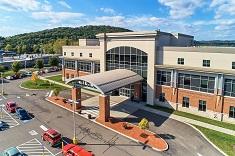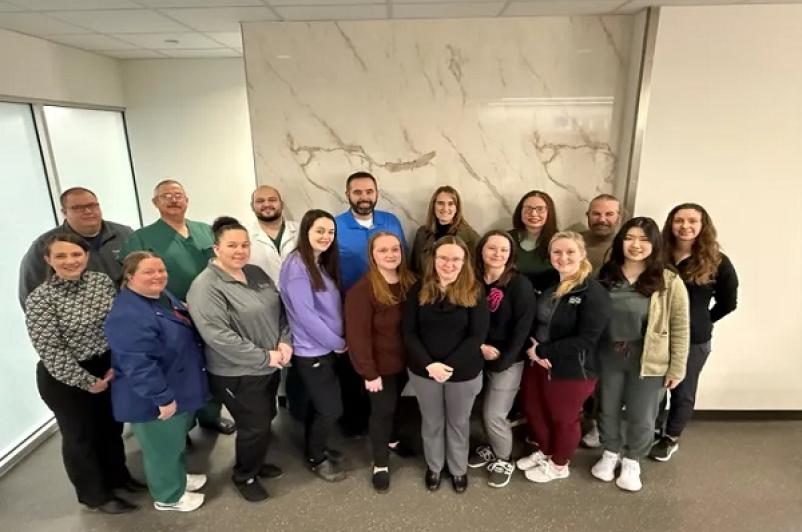
This May, nearly 65,000 Americans will experience a stroke. Many won’t realize they were at risk until it happens. Even more concerning, less than one-third of stroke patients will reach the emergency room within three hours, the critical window for optimal outcomes.
As the region’s first designated Comprehensive Stroke Center, UHS is uniquely equipped to provide the highest level of stroke care — from rapid diagnosis to advanced intervention and rehabilitation. During National Stroke Awareness Month, held annually during May, UHS is proud to join with the National Stroke Association to raise awareness of the modifiable risk factors that contribute to nearly 90% of strokes.
Mitigate your risk
Effective stroke prevention begins with recognizing and addressing the risk factors. At the top of the list of highest risk factors for stroke is hypertension (high blood pressure) — a contributing factor in nearly 48% of all strokes. In fact, 8 out of 10 people who experience their first stroke have high blood pressure. Checking and managing your blood pressure is one of the simplest, most effective steps to reduce your stroke risk.
Lifestyle choices matter too. Smoking, lack of physical activity, and a poor diet are all behaviors that significantly raise your risk. For instance, smokers are two to four times more likely to have a stroke than nonsmokers or those who quit more than 10 years ago.
UHS and the Stroke Association urge everyone to take a moment and commit to changing at least one stroke risk factor. Even small changes can have a major impact. Here’s how much you can reduce your risk of stroke by eliminating the following risk factors:
- Hypertension: 47.9%
- Physical inactivity: 35.8%
- Lipids (blood fats): 26.8%
- Poor diet: 23.2%
- Obesity: 18.6%
- Smoking: 12.4%
- Heart causes: 9.1%
- Alcohol intake: 5.8%
- Stress: 5.8%
- Diabetes: 3.9%
With so many factors at play, navigating your level of risk can feel overwhelming. A great first step is to make an appointment with your family provider to start a personalized discussion about your risks and the steps you can take to mitigate them.
If it’s been some time since you had your last check-up, or if you do not currently have regular visits with a primary care provider, National Stroke Awareness Month is a great time to change that. To find and schedule an appointment with a UHS primary care provider, visit nyuhs.org or click here.
Recognize the signs
But knowing how to prevent a stroke is only half the battle — recognizing the signs of one is just as important. Time is critical, and faster treatment leads to better outcomes. Sadly, fewer than half of 911 calls for a stroke are made within an hour of symptom onset, and many callers don’t realize that stroke is the cause.
A helpful way to recognize stroke symptoms and know what to do if you suspect you or someone near you is having a stroke is the acronym BE FAST:
- B – Balance: Sudden loss of balance or coordination.
- E – Eyes: Sudden blurred or double vision or loss of vision in one or both eyes.
- F – Face: Ask the person to smile. Does one side of the face droop?
- A – Arms: Ask them to raise both arms. Does one arm drift downward?
- S – Speech: Ask them to say a simple sentence. Is their speech slurred or strange?
- T – Time: If you observe any of these signs, call 911 immediately.
It is also critical not to assume strokes only affect older adults. While risk increases with age, strokes can happen at any time of life. In fact, 15% of ischemic strokes occur in young adults and adolescents.
Stroke remains the fifth leading cause of death and a major cause of adult long-term disability—yet many Americans still cannot recognize the symptoms. That’s why public awareness is critical, and why now is the time to act.
The very best stroke care, close to home
In the event you or a loved one experiences a stroke emergency, it is important to know where to go to receive the highest quality care. UHS offers around-the-clock, state-of-the-art stroke care, from emergency response to specialized treatment and recovery.
This year, UHS became the first program in the Greater Binghamton and northern Pennsylvania region to earn The Joint Commission‘s Gold Seal of Approval® for Comprehensive Stroke Center Certification, the most advanced stroke certification offered by The Joint Commission.
To earn this certification, UHS underwent a rigorous evaluation process during which a team of Joint Commission reviewers conducted an on-site assessment to verify compliance with certification standards.
These standards include:
- 24/7 availability of an acute stroke team
- Comprehensive diagnostic testing services
- Experience providing the most complex stroke treatments
- The 24/7 ability to meet the needs of two complex stroke patients at the same time
To learn more about this high-level certification, click here.
This Stroke Awareness Month, make it a point to learn your risk factors, recognize the symptoms, and take steps to protect yourself and your loved ones. You just might save a life!
To learn more about stroke care at UHS, click here.


